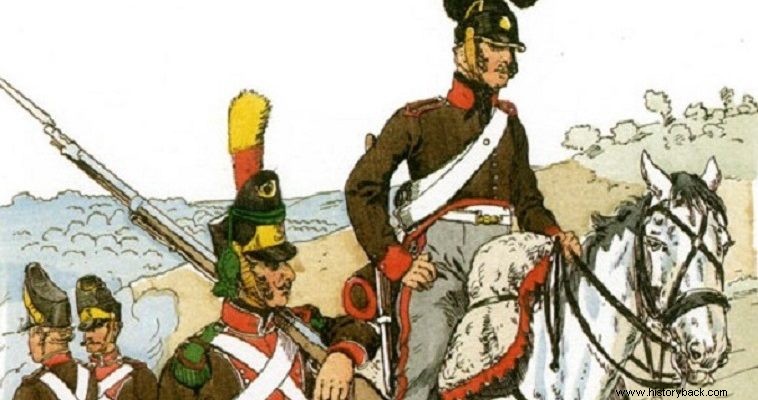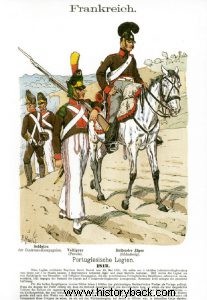
In November 1807 French and Spanish forces invaded Portugal and easily occupied it. The declining Portuguese army was disbanded without a fight and the country surrendered to the French general Zunot. Immediately after the conquest of the country, Napoleon ordered the formation of a "Portuguese Legion" in which the best soldiers of the disbanded Portuguese army would be enlisted, including the men of the only elite, in a way, body of this "Light Legion".
Thus a corps of 9,000 men was formed. These men comprised five regiments of light infantry, one battalion of select "Hunters", three regiments of mounted hunters (light cavalry), one artillery, one plain infantry battalion and one plain ili. The Legion began to be formed from February 1808 and its men were trained under the French regulations of 1791. In April 1808 the Legion left Portuguese soil and crossed into Spain with the intention of going to France and from there to Germany. In Salamanca, however, almost half of the Portuguese "legionaries" deserted and joined their compatriots and the Spanish rebels who were fighting the French, becoming a valuable reinforcement for them. However, cavalry and elite Hunters of the Legion fought in Spain in favor of the French.
When it arrived in Grenoble, France, the Legion numbered only 4,500 men. Its first commander was Pedro José d'Almeida, Marquis of Alorna. The Legion acted in the war of 1809 against Austria. For this occasion, the best men of its battalions were detached and formed the elite 13th Hemi-Brigade (regiment) which was "resurrected" in 1940 as part of the French Foreign Legion.
The Portuguese Legion fought against the Austrians and distinguished itself in the battle of Etchendorf and in the particularly cruel and deadly battle of Bagram (1809), included in the 3rd Division of the 2nd Army Corps of Udine. Three battalions and two islands took part in the battle. Legion with a total strength of 1,650 men. More than 400 of them perished. But the worst was ahead as in 1812 he marched into Russia. the Legion due to losses and desertions had been regrouped in 1811 and now extended to three regiments of infantry, one regiment of cavalry and one regiment of infantry.
The Portuguese Legion fought bravely in Russia, first at the great battle of Smolensk, at Valutinaya Gora, at Polotsk, then at Vitebsk, and finally at the slaughter of Borodino, suffering disastrous losses. Three Portuguese regiments (actually battalion strength) fought at Borodino, attached to the 10th and 11th Divisions of Marshal Ney's 3rd Army Corps and the 6th Division of Udiño's 2nd Army Corps. According to the Württemberg (German) Major Faure:"The Portuguese almost disappeared, during the attack against the Russian fortifications, filling the field with their dead"...
After the terrible retreat from Russia the Legion was left with a deficient battalion and a rudimentary flat battalion. A total of 965 Portuguese survived the Russian campaign. The Legion's 1st Cavalry Regiment operated independently of the infantry in Lithuania. The Portuguese also fought bravely in the battle of Krasni and Berezina, during the retreat. On 25 November 1813 the Legion was disbanded and its men formed a special Engineer battalion. But this too was dissolved, on May 5, 1814.
Already then Portugal and Spain had freed themselves from the French yoke and British, Portuguese and Spanish troops had invaded France and no one guaranteed the loyalty of the Portuguese legionnaires to the Napoleonic regime. Of the legionnaires who survived the trials. they returned to their homeland where they were treated as traitors and some suffered consequences. Napoleon, however, held his Portuguese soldiers in high esteem and named the Legion "Black Infantry", although the men wore brown uniforms and not black.

